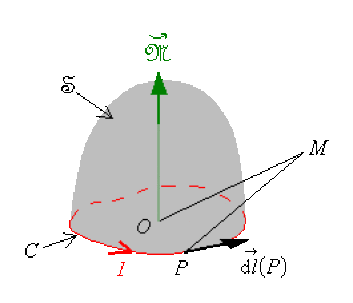Potentiel vecteur créé par un dipôle magnétostatique
On appelle dipôle magnétostatique une distribution de courants dont les dimensions sont faibles par rapport aux distances auxquelles on se place pour étudier ses effets.
Soit un circuit filiforme \(\mathsf{C}\) parcouru par un courant continu d'intensité \(\mathsf{I}\).
Le potentiel vecteur créé par cette distribution de courant en un point \(\mathsf{M}\), a pour expression :
\(\vec A(M) = \frac{\mu_0}{4\pi} \oint_{\mathcal{C}} I \frac{\overrightarrow{\mathrm{d}l}(P)}{PM}\)
Soit un champ uniforme quelconque de vecteur unitaire \(\vec u\).
Le produit scalaire \(\vec A(M) . \vec u\) s'écrit :
\(\vec A(M) . \vec u = \frac{\mu_0I}{4\pi} \oint_{\mathcal{C}} . \frac{\vec u .\mathrm{ }\overrightarrow{\mathrm{d}l}(P)} {PM}\)
En appliquant la formule de Stokes (voir rotationnel[1]) on a :
\(\vec A(M) . \vec u = \frac{\mu_0I}{4\pi} \oint_{\mathcal{C}} . \frac{\vec u}{PM} .\mathrm{ }\overrightarrow{\mathrm{d}l}(P) = \frac{\mu_0I}{4\pi}\iint_{\mathfrak{S}}(\stackrel{\hookrightarrow}{\mathrm{rot}} \frac{\vec u}{PM}) . \stackrel{\hookrightarrow}{\mathrm{d}\mathfrak{S}}\)
\(\mathfrak{S}\) étant une surface ouverte s'appuyant sur le circuit \(\mathsf{C}\), l'orientation de \(\mathfrak{S}\) est fixée par le sens de circulation du courant dans le circuit \(\mathsf{C}\).
Dans le calcul de l'intégrale précisons que \(\mathsf{P}\) est le point courant et \(\mathsf{M}\) le point fixe.

Ainsi nous explicitons \(\stackrel{\hookrightarrow}{\mathrm{rot}} \frac{\vec u}{PM}\) par rapport aux coordonnées de \(\mathsf{P}\) et pour lever toute ambiguïté nous le précisons en indice
\(\stackrel{\hookrightarrow}{\mathrm{rot}_p} \vec u \frac{1}{PM} = \frac{1}{PM} \stackrel{\hookrightarrow}{\mathrm{rot}_p}\vec u + \overrightarrow{\mathrm{grad}}_{p} \frac{1}{PM} \wedge \vec u = \overrightarrow{\mathrm{grad}}_{p} \frac{1}{PM}\wedge \vec u~,\)
car \(\stackrel{\hookrightarrow}{\mathrm{rot}_p} \vec u = \stackrel{\hookrightarrow}{0}\).
Comme \(\overrightarrow{\mathrm{grad}}_{p} \frac{1}{PM} = \frac{\overrightarrow{PM}}{PM^3}~,\)
on a : \(\stackrel{\hookrightarrow}{\mathrm{rot}_p} \frac{\vec u}{PM} = \frac{\overrightarrow{PM}}{PM^3}\wedge \vec u\)
On peut alors écrire : \(\displaystyle{\vec A(M) . \vec u = \frac{\mu_0I}{4\pi} \iint_{\mathfrak{S}}\Big[\Big(\frac{\overrightarrow{PM}}{PM^3}\wedge \vec u\Big) . \stackrel{\hookrightarrow}{\mathrm{d}\mathfrak{S}}\Big]}\)
Le produit mixte[2] sous le signe somme peut s'expliciter d'une manière différente :
\(\displaystyle{\vec A(M) . \vec u = \frac{\mu_0I}{4\pi} \iint_{\mathfrak{S}}\Big[\Big(\frac{\overrightarrow{PM}}{PM^3}\wedge \vec u \Big) . \stackrel{\hookrightarrow}{\mathrm{d}\mathfrak{S}}\Big] = \frac{\mu_0I}{4\pi} \iint_{\mathfrak{S}}\Big[\Big(\stackrel{\hookrightarrow} {\mathrm{d}\mathfrak{S}} \wedge \frac{\overrightarrow{PM}}{PM^3}\Big) . \vec u\Big]}\)
Cette relation étant valable quelque soit \(\vec u\) (démonstration[3]), on a :
\(\displaystyle{\vec A(M) . \vec u = \frac{\mu_0I}{4\pi} \Big[\iint_{\mathfrak{S}} \stackrel{\hookrightarrow}{\mathrm{d}\mathfrak{S}} \wedge \frac{\overrightarrow{PM}}{PM^3}\Big] . \vec u}\)
Soit : \(\vec A(M) = \frac{\mu_0I}{4\pi} \iint_{\mathfrak{S}} \stackrel{\hookrightarrow}{\mathrm{d}\mathfrak{S}} \wedge \frac{\overrightarrow{PM}}{PM^3}\)
Compte tenu de la définition du dipôle magnétostatique, les propriétés du circuit \(\mathsf{C}\) sont étudiées à grande distance et on peut remplacer \(\overrightarrow{PM}\) par \(\overrightarrow{OM}\), \(\mathsf{O}\) n'étant pas n'importe quel point mais "un point moyen du circuit". On a ainsi :
\(\vec A(M) = \frac{\mu_0I}{4\pi} \iint_{\mathfrak{S}} \stackrel{\hookrightarrow}{\mathrm{d}\mathfrak{S}} \wedge \frac{\overrightarrow{OM}}{OM^3}\) que l'on peut aussi écrire, puisque \(\mathsf{O}\) et \(\mathsf{M}\) sont fixés
\(\displaystyle{\vec A(M) = \frac{\mu_0}{4\pi}\Big(I \iint_{\mathfrak{S}} \stackrel{\hookrightarrow}{\mathrm{d}\mathfrak{S}}\Big) \wedge \frac{\overrightarrow{OM}}{OM^3}}\)